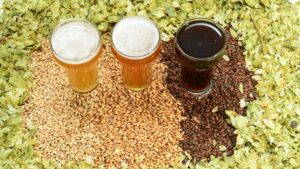 Step back in time to uncover the ancient secrets of beer brewing techniques. From the sands of Egypt to the hills of Mesopotamia, civilizations long past perfected the art of crafting this beloved beverage. Delve into the historical roots and innovative methods that laid the foundation for modern brewing practices. Discover how ancient brewers utilized natural ingredients and age-old processes to create unique flavors that stood the test of time. Explore the fascinating world of ancient beer brewing and witness the ingenuity of our ancestors as they transformed simple ingredients into a cultural staple. Uncover the rituals and traditions surrounding beer production that shaped societies and brought communities together.
Step back in time to uncover the ancient secrets of beer brewing techniques. From the sands of Egypt to the hills of Mesopotamia, civilizations long past perfected the art of crafting this beloved beverage. Delve into the historical roots and innovative methods that laid the foundation for modern brewing practices. Discover how ancient brewers utilized natural ingredients and age-old processes to create unique flavors that stood the test of time. Explore the fascinating world of ancient beer brewing and witness the ingenuity of our ancestors as they transformed simple ingredients into a cultural staple. Uncover the rituals and traditions surrounding beer production that shaped societies and brought communities together.
Ancient Beer Brewing Techniques
 Ancient beer brewing techniques encompassed a variety of innovative processes developed by early civilizations like the Egyptians and Mesopotamians. These ancient cultures crafted distinctive flavors by utilizing natural ingredients such as barley, wheat, dates, and honey. The brewing methods of these societies laid the foundation for modern beer production, showcasing a blend of artistry and ingenuity. In ancient times, beer fermentation primarily occurred in clay vessels or large pots. These vessels provided the ideal environment for the fermentation process, allowing the yeasts to interact with the sugars in the ingredients and produce alcohol. The utilization of these vessels played a crucial role in ensuring the success of the brewing process and the development of unique beer flavors.
Ancient beer brewing techniques encompassed a variety of innovative processes developed by early civilizations like the Egyptians and Mesopotamians. These ancient cultures crafted distinctive flavors by utilizing natural ingredients such as barley, wheat, dates, and honey. The brewing methods of these societies laid the foundation for modern beer production, showcasing a blend of artistry and ingenuity. In ancient times, beer fermentation primarily occurred in clay vessels or large pots. These vessels provided the ideal environment for the fermentation process, allowing the yeasts to interact with the sugars in the ingredients and produce alcohol. The utilization of these vessels played a crucial role in ensuring the success of the brewing process and the development of unique beer flavors.
Ingredients Used in Ancient Beer Brewing
Ancient beer brewing relied on a variety of natural ingredients that contributed to the unique flavors and cultural significance of the brews.
Grains
Ancient civilizations predominantly used barley and wheat in their beer brewing processes. These grains served as the base for fermentable sugars, essential for alcohol production. Barley, in particular, was favored for its high starch content, aiding in fermentation. Wheat, on the other hand, imparted a distinct character to the brews, creating a diverse range of flavors.
Herbs and Spices
In addition to grains, ancient brewers incorporated a range of herbs and spices into their beer recipes. Ingredients like juniper, coriander, and various local botanicals were used to enhance the flavor profiles and add aromatic complexity to the brews. These botanical additions not only contributed to the taste but also held cultural significance, reflecting the unique traditions and practices of different societies.
Fermentation Process in Ancient Brewing
 Continuing the historical exploration of ancient beer brewing, the fermentation process in these early civilizations played a crucial role in creating diverse and flavorful brews. Utilizing clay vessels for fermentation, brewers in civilizations like Egypt and Mesopotamia established ideal conditions for yeast interaction and alcohol production. In these ancient societies, the fermentation process involved the transformation of fermentable sugars from barley, wheat, dates, and honey into alcohol. Clay vessels provided a stable environment for this process, allowing yeast to thrive and convert sugars into ethanol, resulting in the production of beer with varying degrees of potency. Moreover, the incorporation of herbs and spices, such as juniper and coriander, during fermentation not only added complexity to the flavor profiles but also held cultural significance. These ingredients not only contributed to the taste of the brews but also symbolized the unique traditions and practices of the respective societies. The fermentation process was not just a technical aspect of beer brewing but also held ritualistic and social importance. It was a time where communities gathered to partake in the creation of these libations, fostering connections, and strengthening societal bonds through shared traditions and experiences. By understanding the fermentation process in ancient brewing, we gain insight into the artistry and scientific knowledge that early civilizations possessed, laying the foundation for the rich tapestry of beer culture that continues to evolve and thrive today.
Continuing the historical exploration of ancient beer brewing, the fermentation process in these early civilizations played a crucial role in creating diverse and flavorful brews. Utilizing clay vessels for fermentation, brewers in civilizations like Egypt and Mesopotamia established ideal conditions for yeast interaction and alcohol production. In these ancient societies, the fermentation process involved the transformation of fermentable sugars from barley, wheat, dates, and honey into alcohol. Clay vessels provided a stable environment for this process, allowing yeast to thrive and convert sugars into ethanol, resulting in the production of beer with varying degrees of potency. Moreover, the incorporation of herbs and spices, such as juniper and coriander, during fermentation not only added complexity to the flavor profiles but also held cultural significance. These ingredients not only contributed to the taste of the brews but also symbolized the unique traditions and practices of the respective societies. The fermentation process was not just a technical aspect of beer brewing but also held ritualistic and social importance. It was a time where communities gathered to partake in the creation of these libations, fostering connections, and strengthening societal bonds through shared traditions and experiences. By understanding the fermentation process in ancient brewing, we gain insight into the artistry and scientific knowledge that early civilizations possessed, laying the foundation for the rich tapestry of beer culture that continues to evolve and thrive today.

